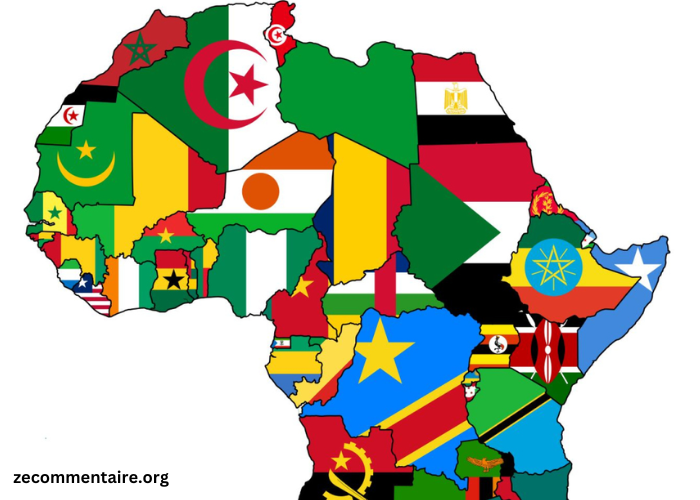The Carte de l’Afrique, or the Map of Africa, serves as a vital tool for understanding the diverse and complex tapestry of the African continent. Africa, known for its rich history, diverse cultures, and vast landscapes, is a continent that requires more than just a cursory glance to appreciate fully. This comprehensive guide delves into the significance of the Carte de l’Afrique, exploring its geographical, cultural, and historical aspects, and highlighting how it reflects the continent’s dynamic nature.
The Geographical Layout of Africa
The Carte de l’Afrique provides a detailed view of Africa’s geographical layout, showcasing its 54 recognized countries, each with its own unique borders and features. Africa is the second-largest continent in the world, covering approximately 30.2 million square kilometers, which includes a wide variety of terrains such as deserts, rainforests, savannas, and mountain ranges.
The continent is divided into several distinct regions, each with its own geographical characteristics. North Africa is dominated by the Sahara Desert, one of the largest hot deserts in the world. This region includes countries like Egypt, Libya, and Algeria, known for their historical significance and strategic location.
Sub-Saharan Africa, the area south of the Sahara, is incredibly diverse. It includes the Sahel region, a semi-arid belt that transitions into the lush and dense rainforests of Central Africa. The East African Rift, a tectonic plate boundary, runs through countries like Kenya and Ethiopia, creating dramatic landscapes with highlands and deep valleys. Southern Africa features the Kalahari Desert and the majestic Drakensberg Mountains, while West Africa is known for its savannas and extensive river systems, including the Niger and Senegal rivers.
The Carte de l’Afrique highlights the continent’s extensive coastline, stretching over 30,000 kilometers. This coastline is punctuated by notable geographical features such as the Cape of Good Hope in South Africa and the Red Sea along the northeastern edge of the continent.
Cultural Diversity Reflected in the Carte de l’Afrique
The Carte de l’Afrique is not merely a geographical representation; it is also a reflection of Africa’s immense cultural diversity. The continent is home to thousands of ethnic groups, languages, and cultural practices, each contributing to the rich mosaic that defines Africa.
In North Africa, the cultural influence of Arab and Berber civilizations is evident. Countries like Morocco, Tunisia, and Egypt have a rich heritage that blends indigenous traditions with Islamic influences. The historical cities of Marrakech, Cairo, and Tunis are renowned for their architectural marvels, such as the ancient pyramids and grand mosques, which are highlighted on the map.
West Africa is known for its vibrant cultures, which include the music and dance traditions of the Yoruba, Hausa, and Wolof peoples. The historical legacy of the ancient empires of Ghana, Mali, and Songhai is also a significant part of the region’s cultural identity. The Carte de l’Afrique showcases landmarks such as the Great Mosque of Djenné in Mali and the historical city of Timbuktu.
Central Africa is characterized by its diverse ethnic groups and the influence of Bantu culture. The Congo Basin, marked on the map, is home to the world’s second-largest rainforest, which plays a crucial role in the traditional lifestyles of the indigenous peoples.
In East Africa, the map highlights the cultural heritage of the Maasai and Kikuyu peoples, known for their distinctive clothing, rituals, and art. The influence of Swahili culture, a blend of Bantu, Arab, and Persian elements, is evident in coastal regions like Kenya and Tanzania.
Southern Africa features a mix of cultures influenced by indigenous traditions and colonial history. The Carte de l’Afrique includes prominent landmarks such as the Robben Island, where Nelson Mandela was imprisoned, reflecting the region’s struggle and triumphs in the fight against apartheid.
Historical Context and Evolution of the Carte de l’Afrique
The Carte de l’Afrique offers insight into the historical evolution of the African continent. Africa’s history is marked by ancient civilizations, colonialism, and the struggle for independence. The map provides a snapshot of how borders and political boundaries have shifted over time, reflecting the continent’s dynamic history.
In ancient times, Africa was home to several powerful civilizations, including the Egyptians along the Nile, the Carthaginians in present-day Tunisia, and the Axumite Empire in Ethiopia. These civilizations are represented on historical maps through their notable landmarks and trade routes.
The colonial period, which began in the late 19th century, dramatically reshaped Africa’s political landscape. European powers drew arbitrary borders that often disregarded ethnic and cultural divisions. The Carte de l’Afrique from this era reflects the colonial divisions imposed by countries such as Britain, France, Belgium, and Portugal. The map highlights the impacts of colonization, including the introduction of new administrative boundaries and changes in territorial control.
The mid-20th century was a time of significant change as African nations gained independence from colonial rule. The Carte de l’Afrique from this period marks the emergence of newly independent states and the redrawing of borders to reflect the sovereignty of African countries. This era also saw the formation of regional organizations such as the Organization of African Unity (OAU), now the African Union (AU), which aimed to promote unity and cooperation among African nations.
The Importance of the Carte de l’Afrique in Modern Times
In contemporary times, the Carte de l’Afrique remains an essential tool for understanding the continent’s political, economic, and social dynamics. The map plays a crucial role in education, policy-making, and global awareness.
For educators and students, the Carte de l’Afrique provides a visual representation of Africa’s geography and cultural diversity. It is used in classrooms to teach about the continent’s physical features, historical evolution, and the interconnections between different regions.
Policymakers and researchers use the map to analyze regional trends, plan development projects, and address challenges such as climate change, resource management, and infrastructure development. The Carte de l’Afrique helps in understanding the spatial distribution of resources, population density, and environmental issues.
In the realm of international relations, the Carte de l’Afrique is used to discuss trade routes, geopolitical strategies, and diplomatic relations. The map helps in understanding the strategic importance of various regions and the impact of global events on the continent.
The Role of Technology in Mapping Africa
Advancements in technology have significantly enhanced the accuracy and detail of the Carte de l’Afrique. Modern mapping techniques, including satellite imagery and Geographic Information Systems (GIS), have revolutionized the way Africa is represented and analyzed.
Satellite imagery provides detailed and up-to-date views of the continent, capturing changes in land use, environmental conditions, and urban development. GIS technology allows for the integration of various data layers, such as topography, population distribution, and infrastructure, to create comprehensive and interactive maps.
These technological tools enable more precise and dynamic representations of Africa, facilitating better planning, research, and decision-making. The digital Carte de l’Afrique can be updated in real-time to reflect changes and provide users with the most current information.
Conclusion
The Carte de l’Afrique is more than just a geographical representation of the African continent; it is a reflection of Africa’s rich history, diverse cultures, and evolving dynamics. From its detailed geographical layout to its cultural and historical significance, the map offers valuable insights into one of the world’s most complex and fascinating regions.
Understanding the Carte de l’Afrique enhances our appreciation of Africa’s physical features, cultural diversity, and historical evolution. It serves as a crucial tool for education, research, and global awareness, helping us navigate the complexities of the continent and its place in the world. As technology continues to advance, the Carte de l’Afrique will evolve, providing even more detailed and interactive views of this dynamic and vibrant continent.






